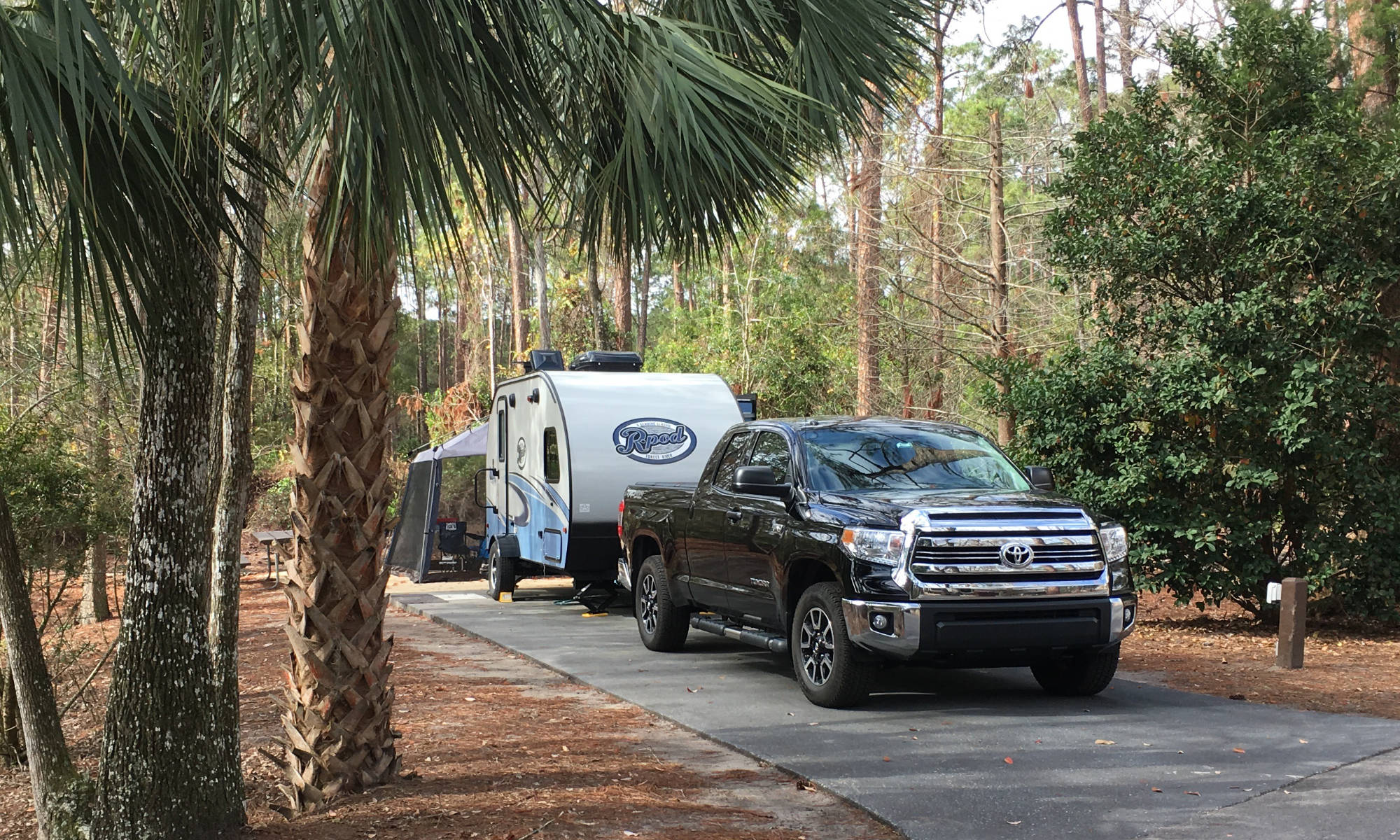In this blog, I’ll talk about my recent challenging experience with my Keystone Bullet’s Dometic furnace, the troubleshooting process we went through, and the step-by-step process we took to fix this issue. Losing a furnace while camping in the winter is no laughing matter and can have serious consequences. If you want a visual representation of this blog, watch the video called: Dometic RV Furnace Breakdown and Step-by-Step Repair.
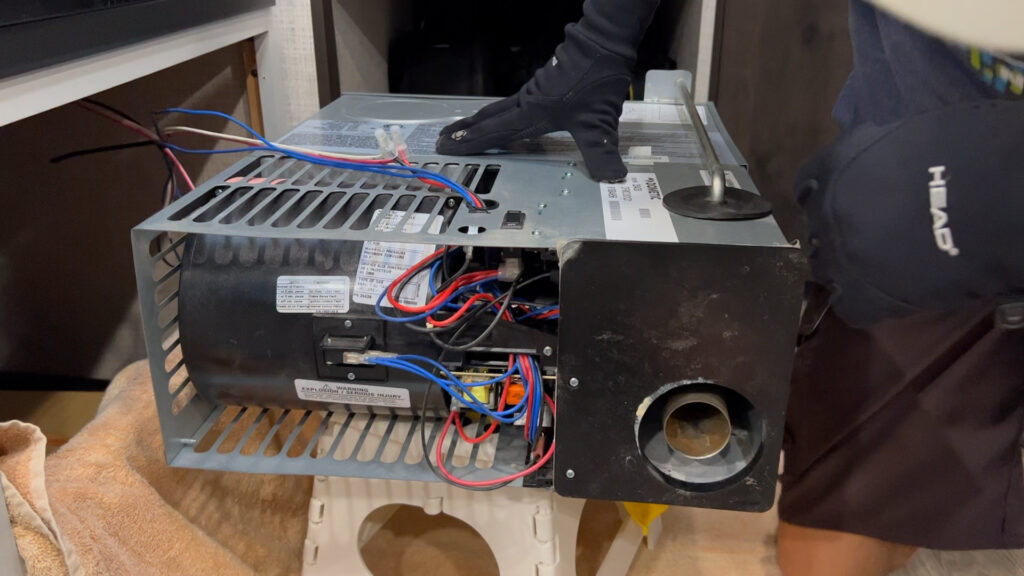
I am somewhat thorough about testing my RV systems before long trips, and this latest trip was no exception. The problem arose with the furnace after a few nights on the road. Temps were below freezing in some of the southern states, and we noticed that the furnace fan would start but not ignite some of the time. This worsened over a few days until the unit would only blow cold air for 30 seconds and never ignite. It made for some cold nights in the RV.
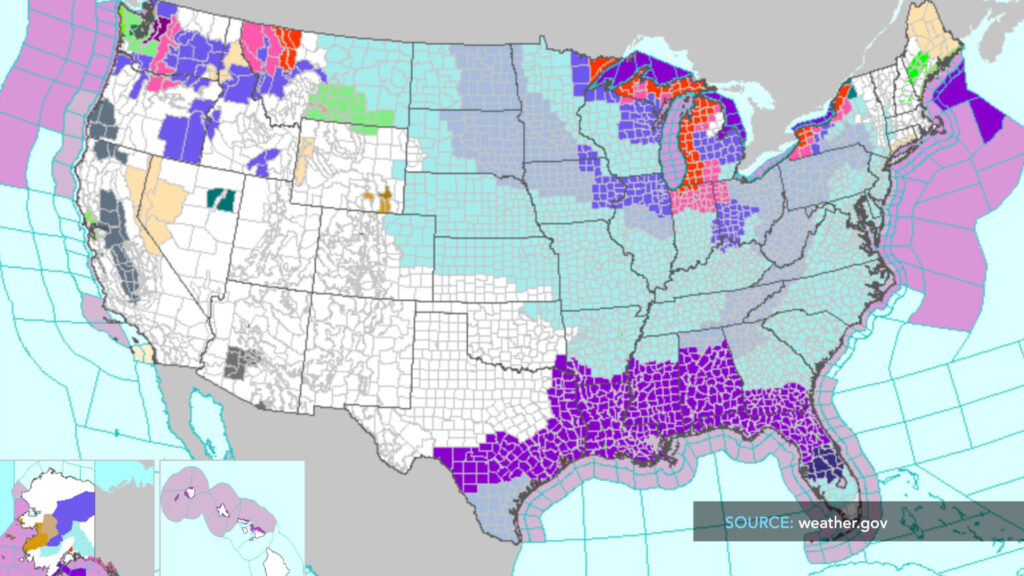
We quickly realized that the furnace wasn’t going to heal itself and started researching the issue. There had been a recall on the propane regulator on my Keystone model, which we took in earlier in the year to have changed, but we decided to try a new one just in case the replaced one was bad. This wasn’t expensive, and I wanted to ensure we eliminated any issue upstream of the furnace first.

After replacing the propane regulator at the tank, the problem persisted. We made sure the other appliances that used propane before and after the furnace were working correctly, which they were. This meant that the furnace itself was where the problem was. After research, we determined that the symptoms pointed to a faulty sail switch not closing when the blower fan was coming on. This switch tells the furnace to ignite the propane, and as it is labeled, it acts like a sail in the blower fan.
There can be two issues that seem to beset the sail switch. The first is debris between the sail and the switch in the unit, and the second is that the switch itself can go bad over time. It is easy to tell if you have debris in your sail switch if you can get to it!

The problem with my situation was that there was no outside access panel to the furnace in my Keystone Bullet. Keystone and many RV manufacturers don’t add the external access panel necessary for easy maintenance. So, I had to entirely remove my furnace to access the sail switch and see if it was the problem. I must fault Keystone for going cheap here and adding an extra hour or two of work to do light maintenance.
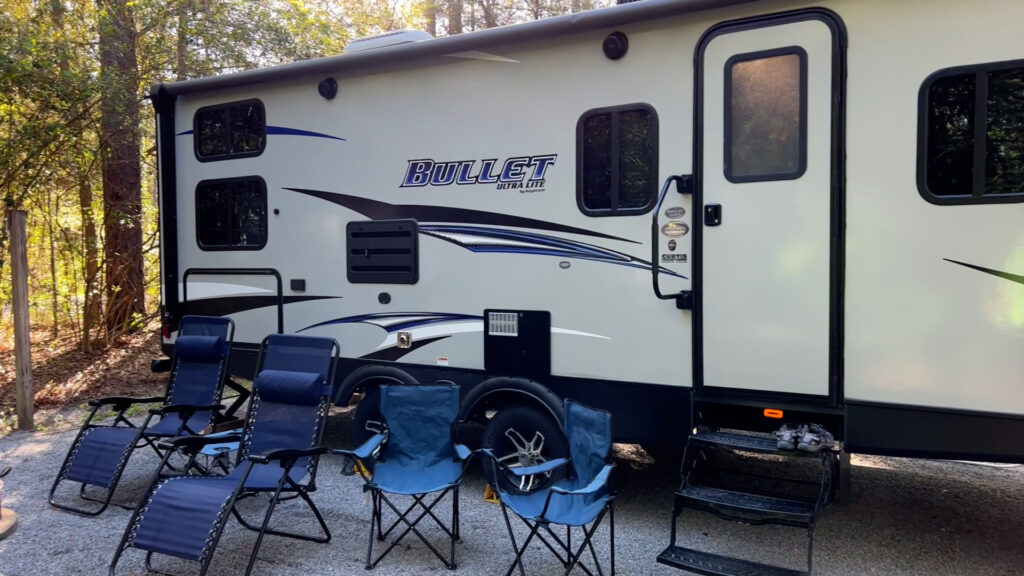
After pulling the furnace, we checked and replaced the sail switch. Given the amount of work involved, I ordered a replacement switch, just in case the original switch was broken. After replacing the switch and reassembling everything, it fixed the issue.
So, let’s go over the step-by-step process of doing this maintenance task. Please be aware that this DIY job is not for everyone, and you need to review this process carefully before deciding to take on this task. We will also have the written process document published on johnmarucci.com in the Resources area. Propane fuel is involved, and if the job isn’t done correctly, it can be very dangerous for you and your RV. If you are uncomfortable with any step in this process, please consult a professional. This process simply walks through how I tackled the issue while on the road.
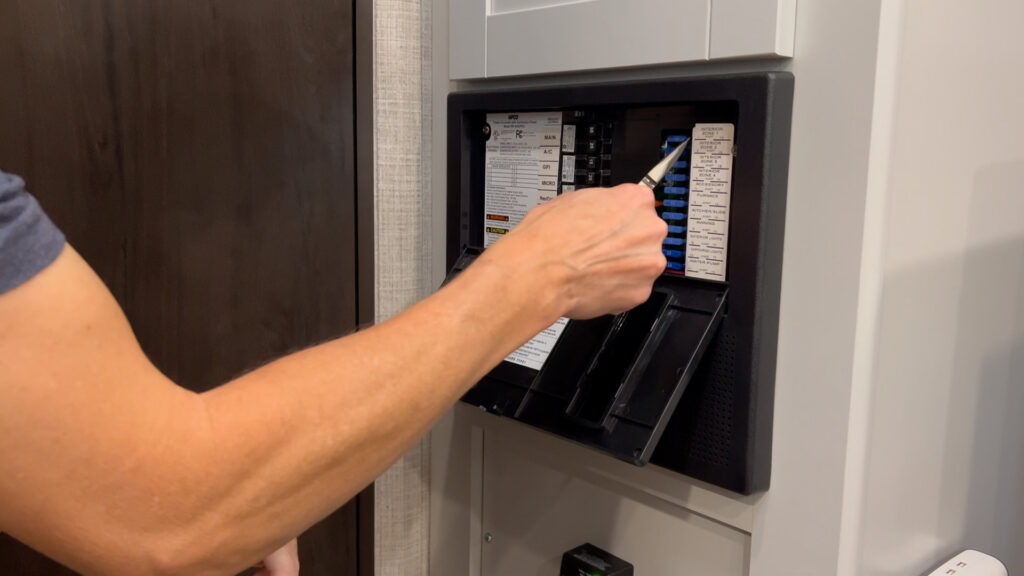
Step 1 – Pull the fuse to your furnace. This is in the electrical panel in your RV. Your fuses should be labeled from the factory, and one should be marked for the furnace. Use a pair of needle nose pliers to remove the proper fuse. Store it somewhere easy to find to reinsert at the end of the process.

Step 2 – Close your propane tanks. Go to the area where your propane tanks are located in or on your RV and turn off all valves on the tanks. You want zero pressurized propane from the tanks to the RV during the process. Again, if you don’t feel comfortable dealing with propane, please contact your dealer or a certified RV tech to help with this work.
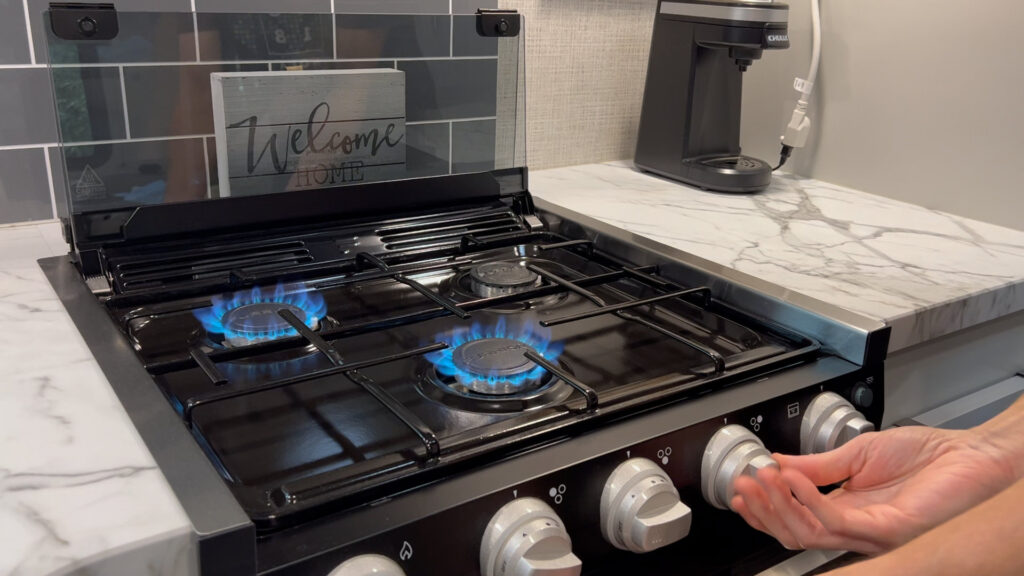
Step 3 – Bleed all propane out of your lines. You’ll need to light your stove in your kitchen and let it run on every burner until the flame dies. Do the same thing with any outside kitchen propane stove. All propane must be properly bled out of the lines.
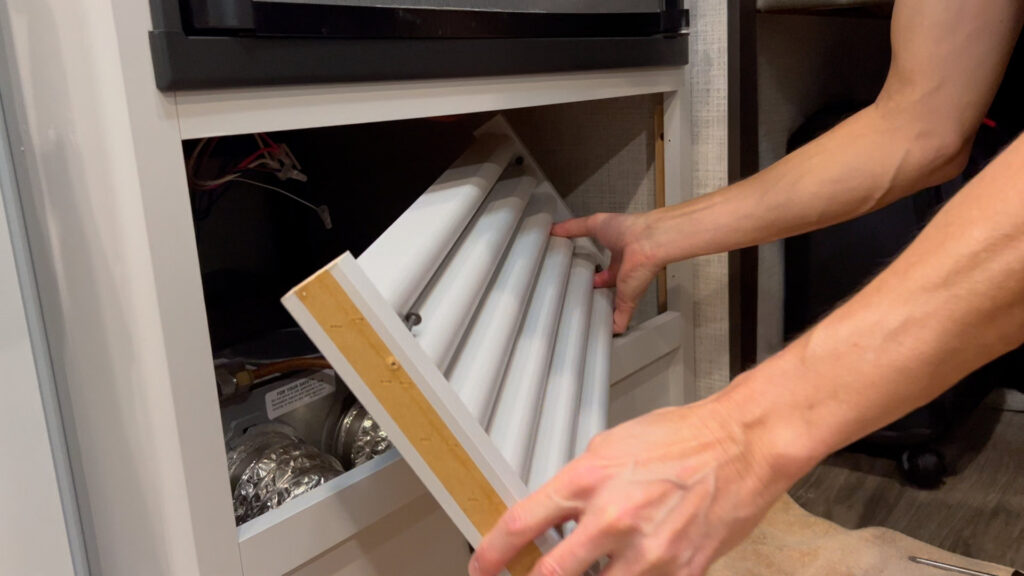
Step 4 – Open any access area to the furnace and examine the layout. If you are fortunate to have an outside hatch to access your furnace, all you need to do is open the hatch to service the sail switch. Otherwise, if you don’t have an outside hatch to your furnace, you likely will need to pull the furnace to service the sail switch. You may have a furnace positioned so that the furnace’s sail switch can be serviced without removing it, but in many cases, the sail switch will be on a side where you can’t easily access it.
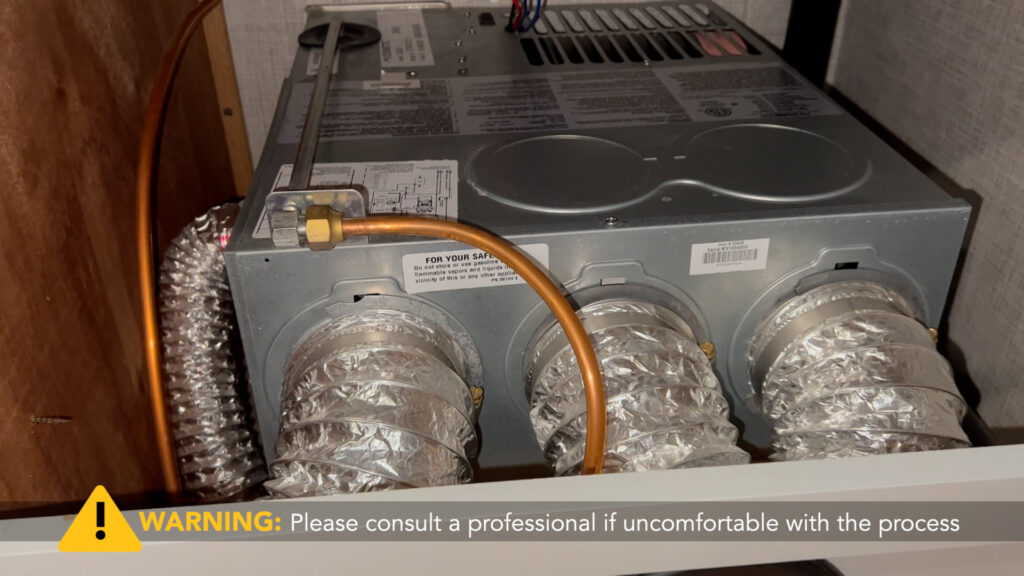
Identify the furnace’s make, model, and serial number for future reference. You may need to do this before you start should you want to procure a new sail switch. Using a smartphone’s camera is an easy way to do this. Given this information, it isn’t too difficult to search online for the correct part.
Examine your furnace carefully. You’ll need to understand the ductwork layout, electrical, propane connection, and furnace exhaust. Take pictures and a video of everything on and around the furnace.
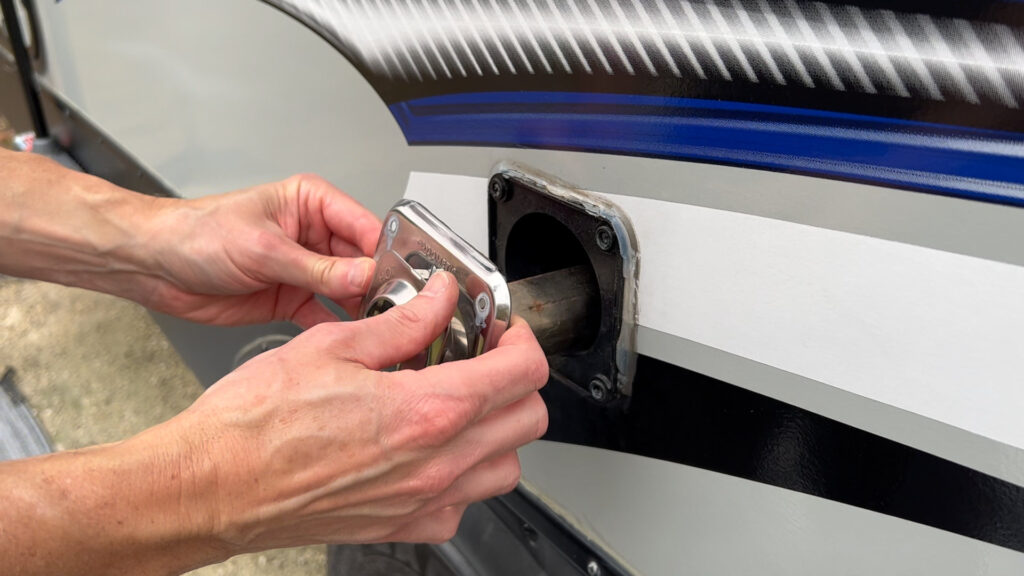
Step 5 – Remove the outside exhaust housings. There usually is a metal exhaust housing for the furnace outside the RV, which will need to be removed to maneuver the furnace out of the space where it sits. My unit also had a hard black plastic inner exhaust manifold that needed to be removed. Carefully cut the caulk around the manifold to loosen it from the outside wall.

Step 6 – Detach any furnace ducting. You likely will need to unhook any attached duct work to remove the furnace. Some ductwork is attached with clamps, and some fit into the furnace manually. Use the appropriate tools to remove any clamps and remove ductwork. Some of the ductwork connectors on my furnace turned to attach or detach from the furnace.
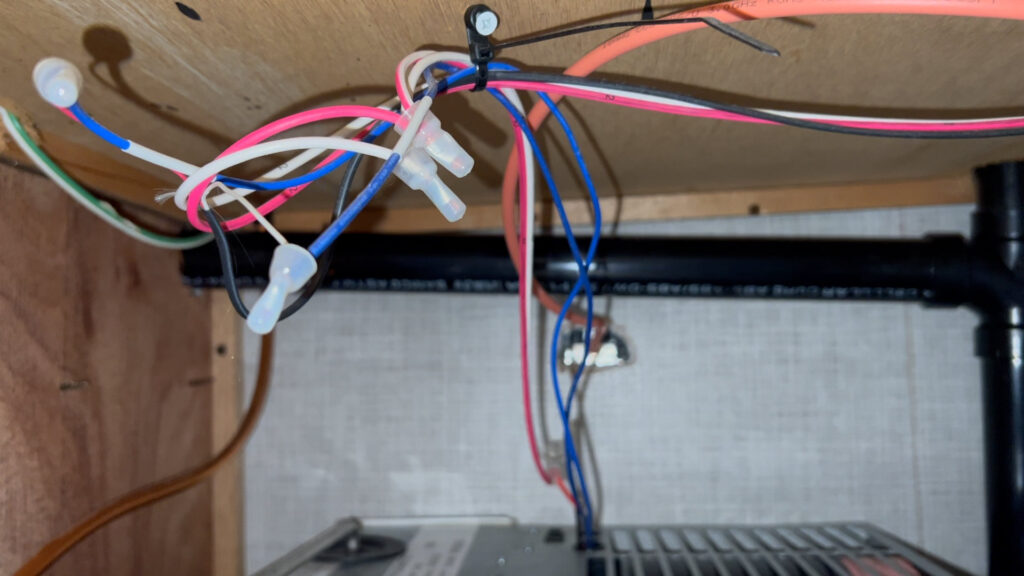
Step 7 – Remove electrical wiring (if needed). You will need to look at the wires connected to the furnace and determine if they have enough slack to remain connected while you remove and service the unit or if they need to be detached. There was plenty of slack in the wires, and I did not need to detach them. If you need to disconnect and reattach the wires later, take a picture of them and label them if needed.
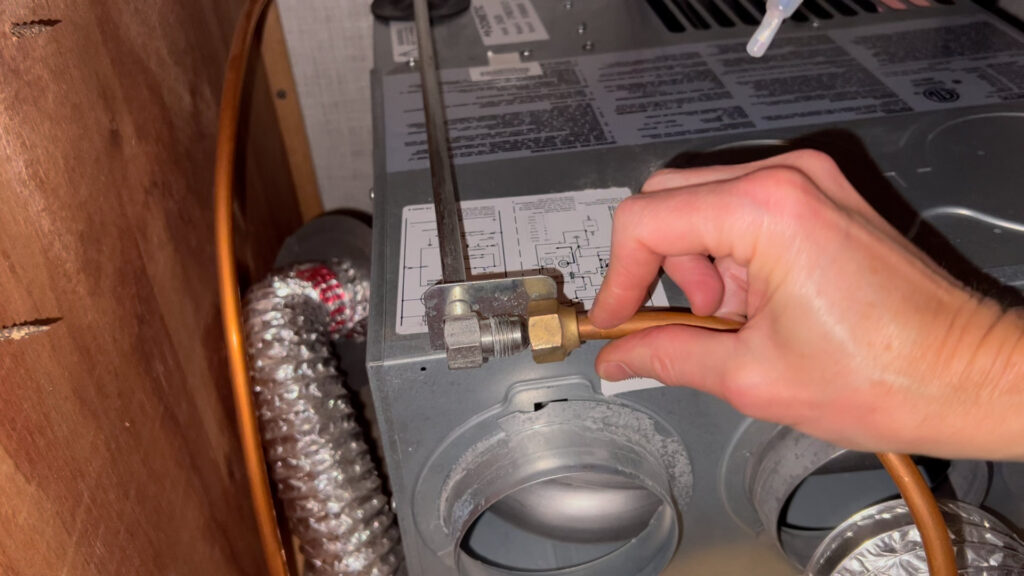
Step 8 – Detach the propane line. Depending on your RV and furnace, you may have a hard metal line to the furnace or a flexible propane line. In either case, you will need to remove the propane line from the furnace to remove the unit. Make sure you look carefully to see if the line connector threads have yellow propane tape on the threads or not. You will need to replace this tape when reinstalling the furnace. Mine had a hard line and no tape.

I used vice grips to hold the intake on the furnace and a crescent wrench to loosen the line. I used the vice grips to hold the intake portion secure, given the torque being applied to the connector.
Also, you may smell some propane once you loosen the line even though you bled the lines. There may still be some trapped propane in this line, so be careful and have no open flame nearby when loosening this line. Also, have proper ventilation, like your RVs exhaust fan, when doing this.
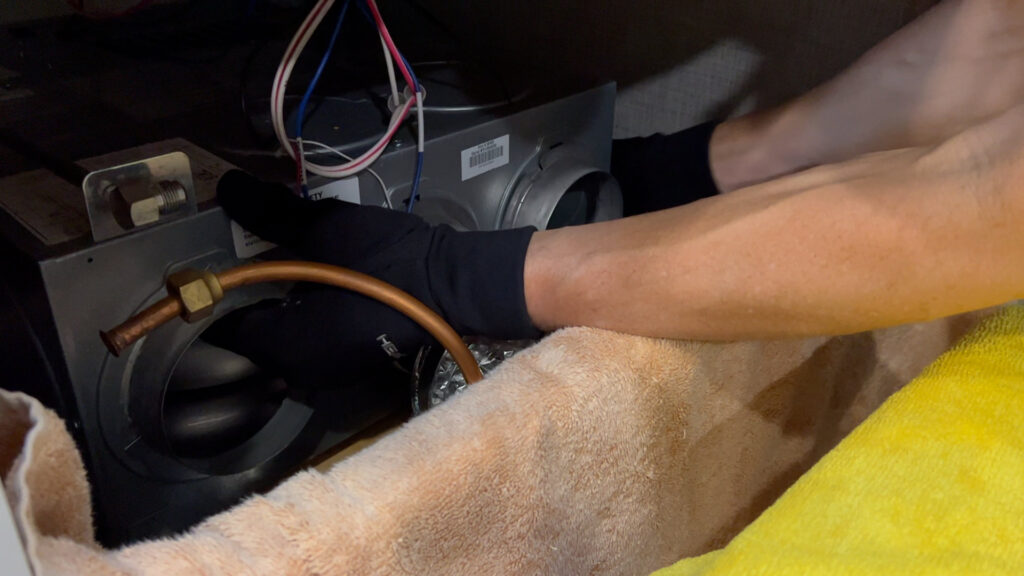
Step 9 – Remove the furnace. Remove the two mounting screws at the bottom of the unit that go into the wooden deck. Put on a decent pair of work gloves and carefully lift the furnace up and out of the space where it sits. I used work gloves because of the sheet metal housing. This past year I had to get stitches due to a deep sheet metal cut, so I strongly advise not handling the sheet metal on the furnace without work gloves. Also, placing a heavy towel on any wood framework you may have to clear when pulling the furnace out is a good idea. You can easily ruin the woodwork with the metal furnace. I also used a folding stool to put the furnace on to work on it.

While the furnace isn’t terribly heavy, pulling the furnace out and clearing the propane line and any woodwork does require decent arm and upper shoulder strength to reach into the space and lift the unit out. It wasn’t an easy lift, given the awkward position. Please keep this in mind when considering doing this task.

Step 10 – Remove and inspect the sail switch. You can find the sail switch by looking on the blower fan housing. It is usually a small item with two wire terminals attached to the switch. Take a picture of the unit with the wires connected for future reference. Remove the wires attached to the sail switch. You can do this with your fingers. Usually, there are two small screws that hold the sail switch to the fan housing. Remove these two screws, and then the sail switch should come out. Keep in mind the direction of the slender sail when removing it. In my case, it was immediately evident that the switch had debris between the sail and switch contact. This would keep the switch from closing, which tells the furnace to ignite the propane.

I could have simply cleaned the switch and reinstalled it at this point, and we likely would have been fine. Yet, after going through the workout to remove and reinstall the furnace, I decided the best plan was to put in the brand-new sail switch.

You’ll have to attach the sail switch to the bracket that came with it, then attach the new switch to the fan housing. Ensure you position the sail in the same direction as how it was removed. Re-plugin the wires to the two terminals in the same way they were detached.
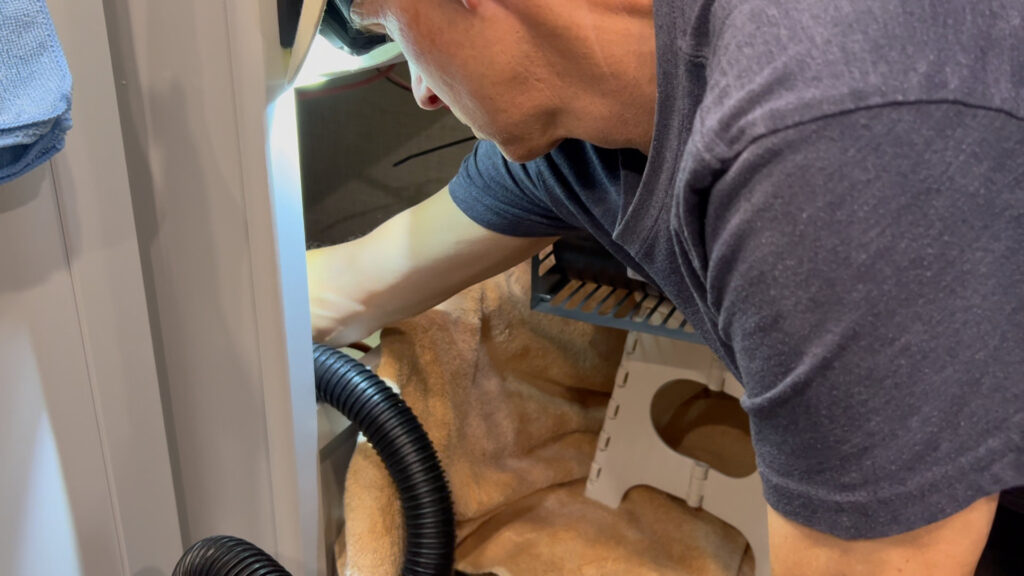
Step 11 – Vacuum out the furnace area. I highly recommend cleaning out the furnace area while you have the furnace out. The main issue that besets the sail switch is floating debris that finds its way into the blower fan. Unlike home furnaces with air filters at the air inlet, RV furnaces generally do not, meaning debris will eventually find its way into the blower fan, causing the sail switch to fail. Cleaning the area will help delay this accumulation of dust and debris.

Step 12 – Reinstall the furnace. With work gloves on, turn the furnace to the original position, lift it over any threshold, and put it back into the recessed area. Be careful not to kink any wires or hit the propane line. Again, this is an awkward lift requiring decent arm and shoulder strength. Reattach the mounting screws into the furnace deck to secure the furnace back to its original location.
Step 13 – Reattach the propane feed line to the furnace. If your threading had yellow propane tape, replace the tape before reattaching the propane line. Otherwise, attach the propane line per the measure of approximate torque the connection had when the line was removed.
Step 14 – Reattach electrical wiring. If you had to disconnect any electrical wiring in an earlier step, use your pictures or labeling and reattach the wires accordingly. In my case, it was a matter of attaching the wiring harness to the access area’s ceiling by way of a bracket and screw.
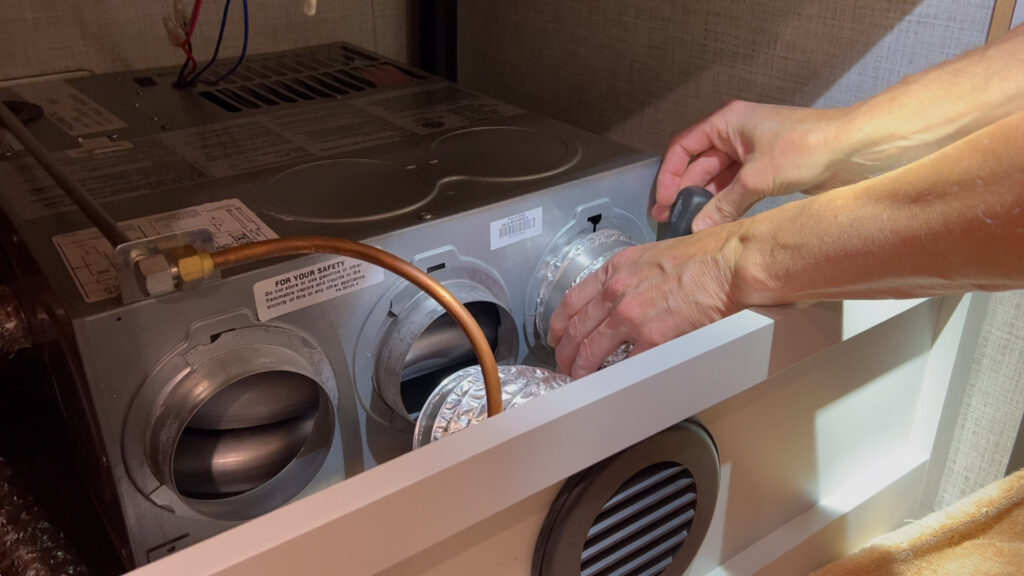
Step 15 – Reattach ductwork. This is done in reverse order to how they were removed. Make sure all ductwork is securely attached. For my unit, the side duct was a manual screw metal plate that had to be put in, while the front ducts were attached with clamps.

Step 16 – Reattach the furnace exhaust. We used narrow strips of butyl tape on the outside wall before attaching the hard black plastic exhaust manifold. This holds the manifold tightly to the outer wall and provides a measure of water resistance. Next, we attached the external metal exhaust manifold with the original screws.
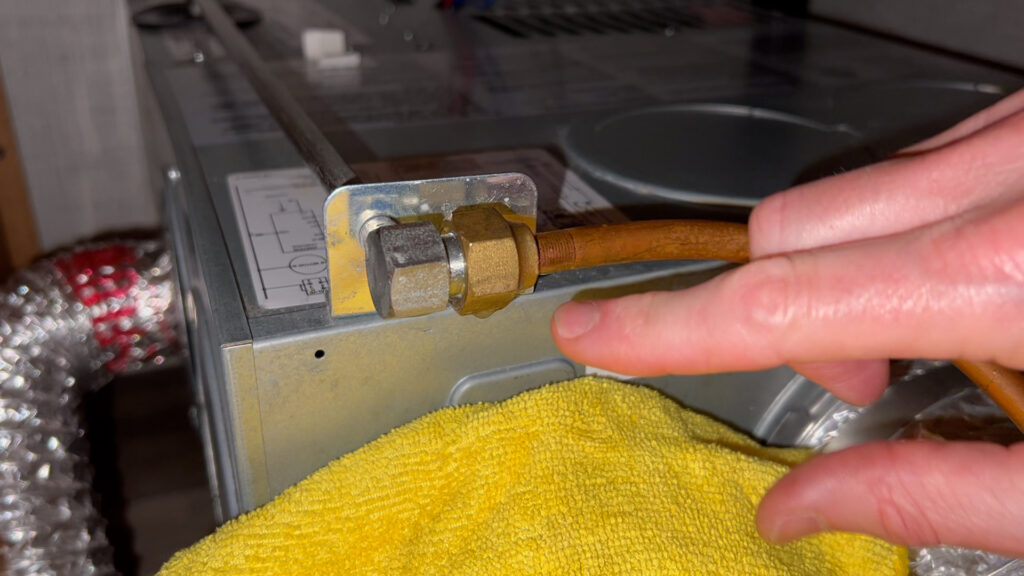
Step 17 – Pressurize the propane lines and test for leaks. Open the valves to your propane tanks. Use soapy water placed on the propane connection at the furnace and look for bubbles. There should be no bubbles. I also tested the kitchen stove to ensure propane was coming through the lines.
Step 18. – Reattach the fuse. Put the fuse into the proper slot in the electrical panel using the needle nose pliers.
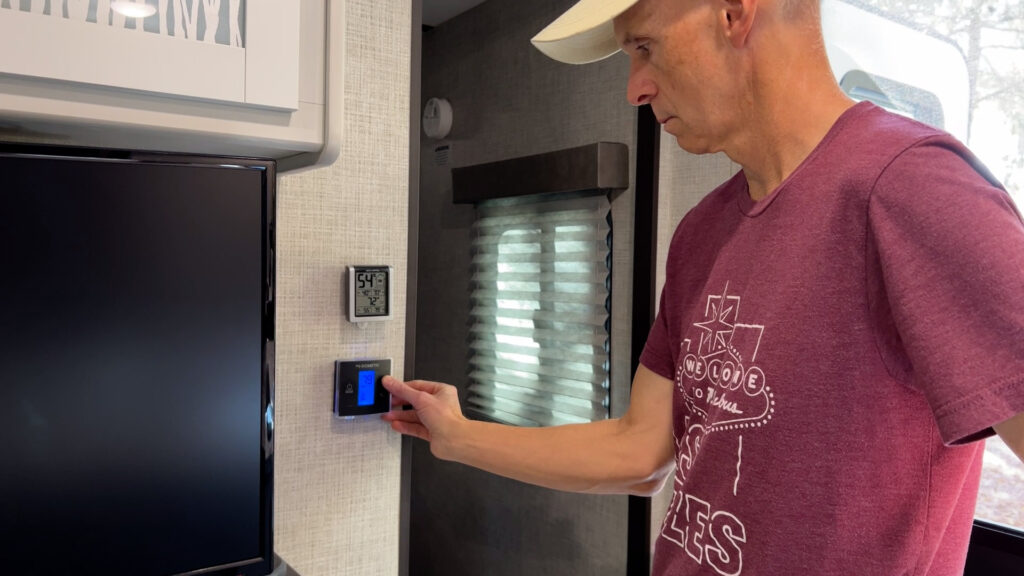
Step 19 – Test the furnace. Turn the thermostat to “Furnace” and raise the temperature until the furnace blower fan comes on. You should hear the furnace ignite within twenty seconds or so of the furnace’s blower fan coming on. Within another minute or so, you should have hot air coming from your RV’s registers.
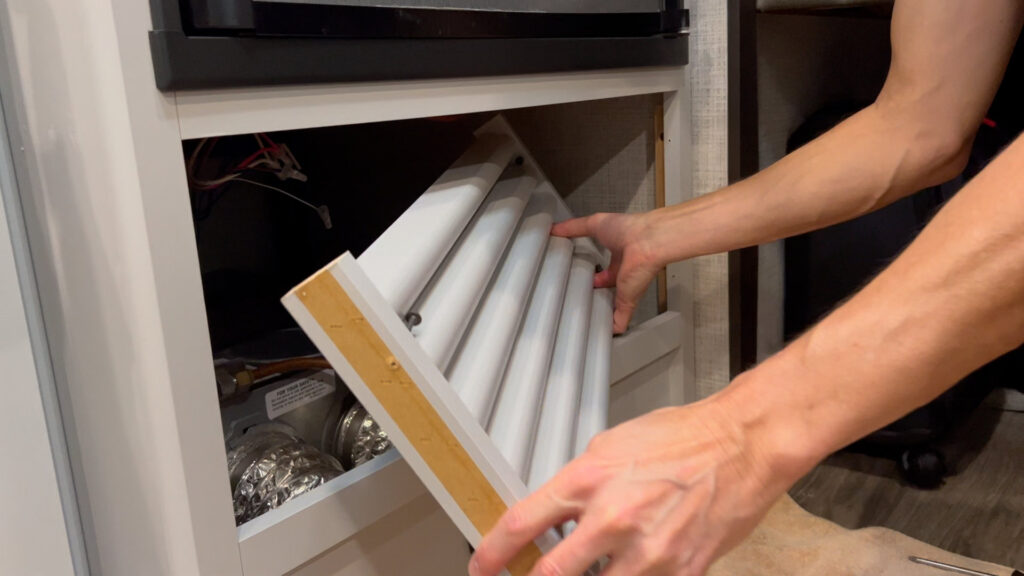
Step 20 – Reattach the access panel. Once you are convinced the furnace is operating correctly, reattach the furnace access panel.
Congrats!
That’ll do it for the step-by-step process of troubleshooting and replacing your furnace’s sail switch. I’m not at all happy that Keystone and other manufacturers fail to provide an easy way to access the furnace from the outside of the RV. It would turn a 90-minute workout into a 10-minute small maintenance job.
All the best in your camping endeavors!
As always, thanks to our fans who support our efforts by starting their shopping from our Amazon Storefront and by their generous financial support by using the THANKS feature located under each YouTube video ($ within the Heart icon). Your support is greatly appreciated!
